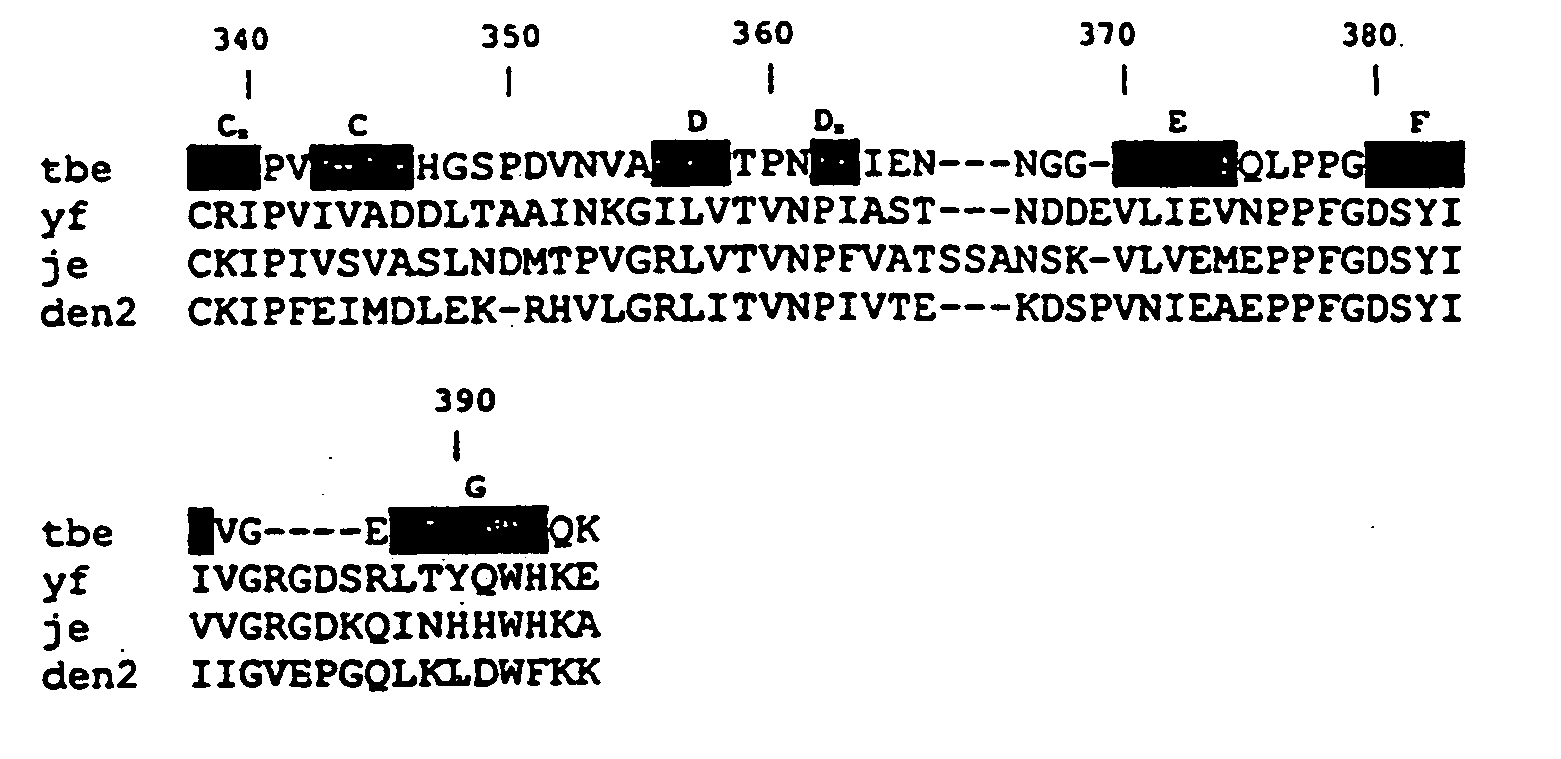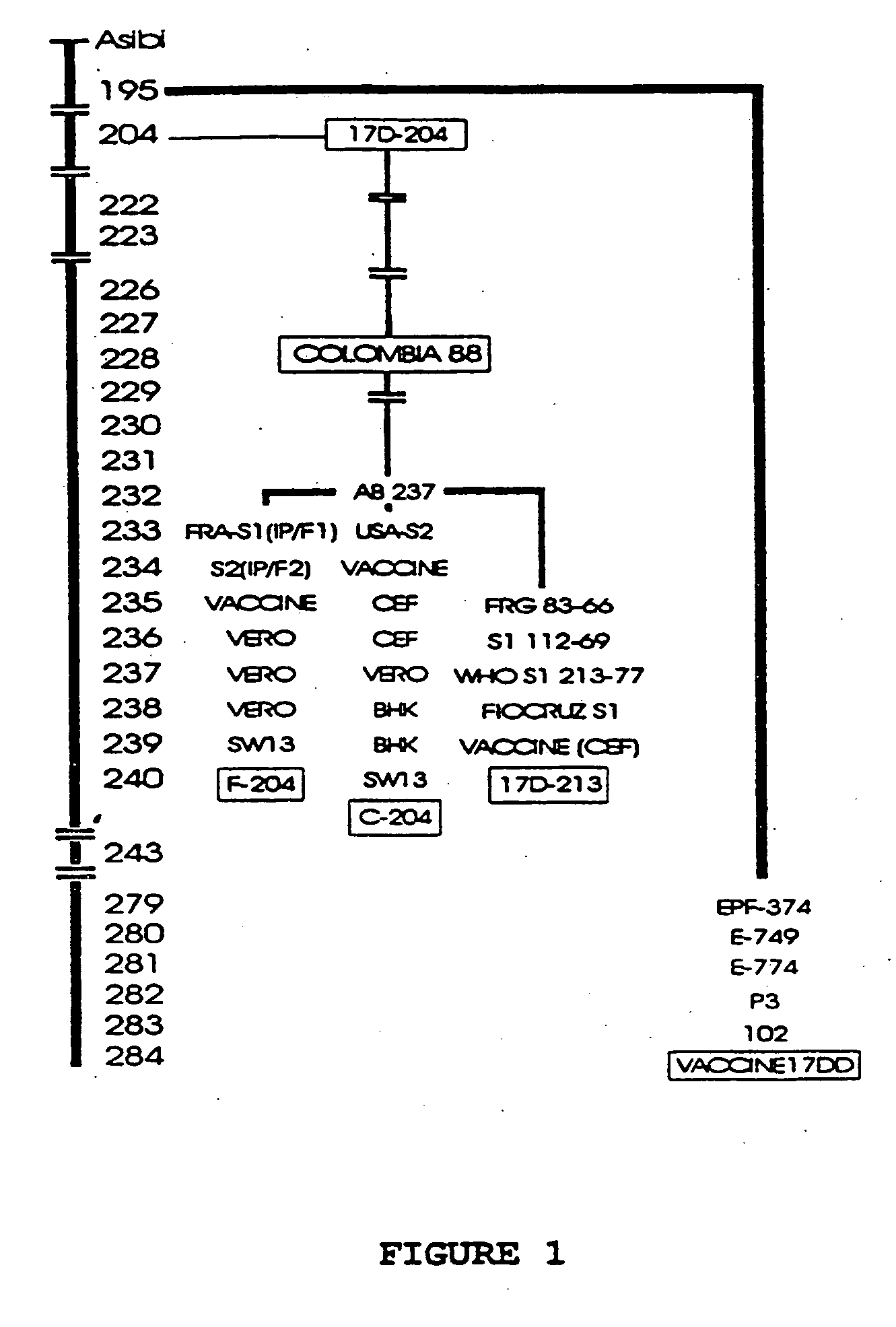Use of flavivirus for the expression of protein epitopes and development of new live attenuated vaccine virus to immunize against flavivirus and other infectious agents
a technology of attenuated dengue virus and flavivirus, which is applied in the direction of immunological disorders, drug compositions, peptides, etc., can solve the problems of reverting back to a pathogenic form over time, milder infection of the host, and genetic instability of attenuated dengue viruses generated so far, and achieves stable expression and immune response. eliciting
- Summary
- Abstract
- Description
- Claims
- Application Information
AI Technical Summary
Benefits of technology
Problems solved by technology
Method used
Image
Examples
example 1
Structural Analysis of the Insertion of Specific Protein Epitopes
[0141] Ten models were produced for the insertion SYVPSAEQI (SEQ ID NO: 9) in the fg loop region using the alignment shown in FIG. 6 in which the insertion is made between E199 and T200. The inserted residues will be refered to as 199A to 199I.
[0142] The pseudo-energies of the beet five models were comparable to those of the native yf model. Their structures are variable as one skilled in the art would expect from an insertion of nine residues in length. The variation in structure of the loop leads to correlated variation in the neighbouring loop between β-stands k and l. The glutamine sidechain of residue Gln199H (ie the eigth residue of the inserted peptide) in several of the best models shows a conformation compatible with the formation of a hydrogen bond via its Nε2 to the carbonyl of Val244 of the opposite monomer in a similar fashion to that made by the Nδ1 of His208 in tbe. One representative model had an over...
example 2
a) Derivation of Plasmid pACNR1180Nde / Sal.
[0153] pACNR1180Nde / Sal, the new version of plasmid pACNR1180, is obtained by removing most of the unique restriction sites of pACNR1180 by digestion with NdeI / SalI, filling in the ends by treating with Klenow enzyme, ligating and transforming E. coli XL1-blue. This new version of pACNR1180 was named pACNR1180Nde / Sal.
b) Derivation of Plasmid pYF17D / 14
[0154] To generate pYF17D / 14, fragments NotI (13,059)-NsiI (11,158) and SalI (3,389)-XhoI (1951) from G1 / 2 plasmid (described in detail in U.S. Pat. No. 6,171,854) were first ligated to NotI / XhoI-digested pACNR1180Nde / Sal. The resulting plasmid was named NSK7 (map not shown) and used to clone the remaining of the YF cDNA contained in plasmid T3 / 27 (described in detail in U.S. Pat. No. 6,171,854) by digestion with NsiI (11,158)-SalI (3,389), ligation of the appropriate fragments and transformation of the same bacterium. The plasmid contains 13449 base pairs and was named pYF17D / 14 (FIG. 4). ...
example 3
Preparation of DNA Template
[0161] The template to be used for the regeneration of YF 17D virus is prepared by digesting the plasmid DNA (YFE200 and T3 / 27) with NsiI and SalI (Promega Inc.) in the same buffer conditions, as recomended by the manufacturer. Ten μg of each plasmid are digested with both enzymes (the amount required is calculated in terms of the number of pmol-hits present in each pDNA in order to achieve complete digestion in 2 hours). The digestion is checked by removing an aliquot (200 ng) and running it on 0.8% agarose / TAE gels. When the digestion is complete, the restriction enzymes are inactivated by heating.
[0162] Linearization of the DNA resulting from the ligation of both NSiI / SalI-digested plasmids is carried out by the use of XhoI, and is performed with buffer conditions according to the manufacturer (Promega). The resulting product is thereafter phenol-chloroform extracted and ethanol precipitated. The precipitate is washed with 80% ethanol and resuspended ...
PUM
| Property | Measurement | Unit |
|---|---|---|
| Electric dipole moment | aaaaa | aaaaa |
| Volume | aaaaa | aaaaa |
| Mass | aaaaa | aaaaa |
Abstract
Description
Claims
Application Information
 Login to View More
Login to View More - R&D
- Intellectual Property
- Life Sciences
- Materials
- Tech Scout
- Unparalleled Data Quality
- Higher Quality Content
- 60% Fewer Hallucinations
Browse by: Latest US Patents, China's latest patents, Technical Efficacy Thesaurus, Application Domain, Technology Topic, Popular Technical Reports.
© 2025 PatSnap. All rights reserved.Legal|Privacy policy|Modern Slavery Act Transparency Statement|Sitemap|About US| Contact US: help@patsnap.com



